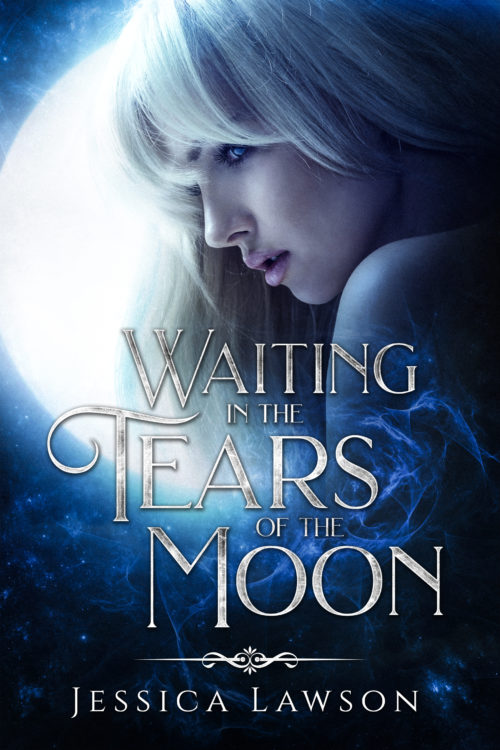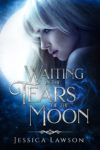The author says:
After waking up in a past life, Kara Walker must find the Moon Princess and prevent her murder.
Nathan says:
I have absolutely no complaints about the technical aspects. Well done.
So the setting is… sometime in the vague past? Unless what you’ve got here is a so-far-into-prehistory-it-counts-as-fantasy setting, it’s probably going to appeal to the time-travel drama crowd (Outlander and such), but only if you give some indication of setting. Different people are drawn to different eras, and those people need a “flag” on the cover to attract their attention, whether it’s a tartan, hieroglyphics, a toga, etc. Otherwise, it’s a very generic cover, with a slight “magical” vibe, suitable for use with any low-intensity urban fantasy or paranormal romance.
Other comments?


Fine design-wise other than the unreadability of the type at any other than full size. The fancier the typeface the better it is to not overcomplicate it by adding shadows, textures, highlights, etc.
I would have to agree with Nathan that the artwork really doesn’t convey much of about the nature or themes of the book.
The Tears and Moon parts of the title I can see and read in the thumbnail, but the Waiting part looks like it could just as easily read Wailing while your byline and the uncapitalized parts of the title are all but invisible at that size. As to whether I can guess the genre… well, my educated guess upon seeing this thumbnail in the feed was that this was basically some kind of anime or manga adapted into prose (the same way one sometimes sees live-action movies adapted from these media). Judging by your brief description, my guess was accurate and this is evidently something like a Sailor Moon fan-fiction.
Of course, if you’re looking to publish this without some kind of legal permission from Sailor Moon‘s franchise owners, you might as well be waving a huge “Sue me!” sign in their faces. A fair number of American anime fans (including none other than yours truly) got their start from Sailor Moon‘s being brought over here in the 1990s, and will immediately recognize the concept of a “Moon Princess” (and being reincarnated as a gal with a fairly typical modern name) as being plagiarized from it. That your protagonist is merely looking for this Moon Princess rather than actually being her (and lacks Tsukino Usagi/Queen Serenity’s odango dumplings hairstyle with the twin tails) will suggest only that this Kara Walker (a portmanteau of Superman’s cousin and female counterpart Kara-El and the Skywalker family from Star Wars, perhaps?) is some kind of Mary Sue equivalent of Aino Minako, a.k.a. Sailor Venus (whose own series as Sailor V immediately preceded Sailor Moon‘s).
Assuming you’ve got these potential legal issues resolved in some manner, that still leaves the question of how to make your cover a bit more readable and recognizable. Having that bright moon blazing out from behind the girl and title is really obscuring them both; you might do better to push it much further back into the background to separate it from them. Another possibility, infinite follicular chromatic variability being a common staple of anime and manga, is that you could make her hair a bright pink or golden orange to provide some much-needed contrast with the pale silvery blue of the moon behind it and the title in front of it.
Any way you play it, though, you’re looking at an awfully limited target audience; just as live-action adaptations of old Japanese line-drawings tend to struggle at the box-office, so too do thinly disguised prose fan-fiction adaptations of anime and manga struggle to draw much interest from fans of these media or fan-fiction readers (who can get a nigh-unlimited supply of their drug of choice for free from numerous places online). The exceedingly rare exception-that-proves-the-rule like E.L. James notwithstanding, authors blatantly scraping for other authors’ table scraps rarely demonstrate enough originality in their work to be successful. If you actually are creative and original enough to be doing something other than an apparent Sailor Moon ripoff, try changing the title and cover motif (yes, that unfortunately means pretty much scrapping the whole cover and starting over) to emphasize some aspect of the story that isn’t easily mistaken for plagiarism from such a well-known anime and manga franchise.
This is boss. The girl looks great and I love the palette. My only technical note is that when I look at the text in full size the letters seem to be aliased in an odd way so they look a bit jaggy and pixely instead of smooth. But it’s only visible at all at the largest resolution, so not a big deal.
I wouldn’t mind seeing the abstract blue stuff and the stars/galaxies on the lower half with a more indicative pattern like flowers or feathers, something that’s easy to identify and meaningful to the book. But fantasy these days–especially YA fantasy, which this certainly sounds like it might be–tends to have very nonindicative covers. So I don’t see any reason to put in an indication of the exact setting unless that’s the main selling point.
(I don’t see any Sailor Moon connection other than the word “moon.”)
I found this. I hope it is legally used stock art. https://kbimages1-a.akamaihd.net/74de52b4-b705-4ea2-801e-17a69e5a4e9e/1200/1200/False/captivated-41.jpg
Of course, that cover in turn is derived from this stock image. Again, if one must use derivative material like stock images, mirroring the image to make it a bit more difficult for an image reverse-search engine to recognize is just common courtesy.
I figured, or at least hoped, that it was a stock image but couldn’t find the original.
Moreover, um… never mind about the mirroring; when I plugged a mirror image of this stock image into Tin Eye’s reverse search engine, it showed me several other instances of it including book covers, just like when I plugged in the original.
I don’t see the connection to Sailor Moon either. Being a popular brand doesn’t mean you own the name Moon. Anyone can use it in any way they like. Only trademarked names can’t be used and you can’t trademark words in common usage. And you can’t own ideas either. It isn’t plagiarism unless she is copying the work as is. (It’s called a trope…) Anyone can write their own story about an epic space battle between two forces and that isn’t plagiarizing Star Wars. You could even call the hero Luke as it’s a common name. The Skywalker part might be a trademark name and it wouldn’t be smart to use it as it isn’t common usage but there are hundreds of books in that genre with the same theme, some very popular.
time travel to right a wrong is a common trope in many genre
I thought YA fantasy when I saw the cover, it had no anime (at least how I picture anime although admittedly I’m not familiar with all its forms) so I don’t see where you get that. I, personally like the cover and think it does it’s job of enticing me to read the blurb
I’ll put it this way: nobody can copyright or trademark the word “billionaire” nor any BDSM-themed imagery either, but if you put them on the cover of your novel, watch how fast people start accusing you of ripping off E.L. James. The cover itself only made me think of live-action adaptations of anime in general; the odd Japanese interest in our planet’s natural satellite didn’t actually start with Sailor Moon. The potential association with Sailor Moon only occurred to me upon reading the description: the Moon Princess and the part about “waking up in a past life” (as in reincarnation?) are two rather important plot points in that anime series.
To be sure, Sailor Moon has Tsukino Usagi and her pals being reincarnated into their future lives, starting out as otherwise typical modern Japanese teenagers. As the series unfolds, however, a number of people from both the past and the future come looking for the Moon Princess (who turns out to be Usagi herself) seeking either to kill or corrupt her, and her reincarnated friends end up having to serve as her bodyguards in addition to everything else they do. Is this plot description starting to sound a bit familiar?
There’s nothing wrong with drawing inspiration from older works. You may never have heard about the comic book series featuring a boy trained in using the “Astro-Force” (which is derived from “the Source”) being raised in ignorance of his true lineage to fight against his own father, who’s the cruel tyrannical ruler of a completely mechanized metallic planet. Though George Lucas would probably never admit it (since DC Comics might have grounds to sue him if he did), Luke Skywalker and his father Darth Vader in Star Wars probably drew pretty heavily from Jack Kirby’s stories about Orion and his father Darkseid on the planet Apokolips in the Fourth World comics.
Still, if you’re going to use so many of the same ideas as one of your predecessors in one of your own works, the least you could do would be to change the names and the phrasing of things in your story enough to make them sound original. George Lucas didn’t call his protagonist Orson or the villain Dark Side, and his world-destroying metallic planetoid was known as the “Death Star” rather than the S.S. Apocalypse. As Dilbert author Scott Adams (who facetiously admits to having ripped a fair number of his jokes from Peanuts and Garfield) puts it, you should always get a stolen car a paint job and change the license plates before driving it past its original owner; that’s just common courtesy.
I’m not going to lie; I’m not a huge anime/manga fan and yet, the first thing I thought of, in reading the description, was “Sailor Moon!,” and yes, time-travel also plays a big part of that series, as RK explains.
I suspect that the storyline has nothing to do with Sailor Moon; but you, submitting author/cover designer, should be aware that the issue may arise, and that lots of people are aware of Sailor Moon, the Moon Princess, etc.
Vis: the cover: I have no real issues with it, other than the fact that the period–either originating or the traveled-to time–are completely indiscernible. I can agree that some sort of clue as to those periods is needed.